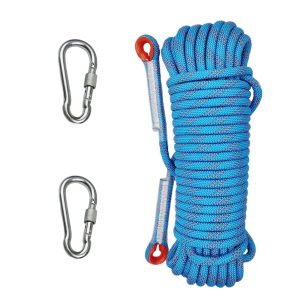Project Report For Climbing Rope
Introduction
Project Report For Climbing Rope is as follows.
A climbing rope is a rope used in rock climbing. It is an important part of the suite of protective equipment (including harnesses, anchors, belay devices, and carabiners) that climbers use to prevent fatal fall-related accidents.
Climbing ropes must adhere to very tight specifications in order to prevent breaking in the case of an unintentional fall. However, they should be lightweight, flexible in knots, and resistant to scraping on sharp, rough rocks. All this in all possible weather conditions.
Ropes made of natural fibers such as hemp and flax were employed in the early days of alpinism, but Kernmantle rope are now used in modern climbing. Kern mantle rope is made out of a core of nylon or other synthetic material that has been braided in a unique fashion and is encircled by a core mantle that has been woven onto it. The main strength of a rope is in its core, and the rope sheath accounts for only a small portion of the overall strength of the rope.
Types Of Climbing Rope
- Static Ropes :- Static ropes are ropes that are specially designed to have little or no stretch. This prevents it from absorbing large impacts. Therefore, it should not be used to protect climbers from falls. On the other hand, they are particularly strong and can withstand large loads under static loads. Used on fixed ropes, ziplines, and shuttles.
- Semi-Static Ropes :- Semi-static ropes have limited elongation. They can absorb small impacts, and withstand static loads, but are very strong. However, these ropes must not be used to prevent climbers from falling. They are used as fixed ropes in rescue operations and caving.
- Dynamic Ropes :- Dynamic ropes are used in sport climbing. It’s stretchy enough to safely stop a fall. However, it is relatively weak for static loads and should not be used for zip lines or amusement park rides. When a climber falls, it immediately creates a huge amount of kinetic energy. This energy is released when the climber stops falling. Part of this energy is sent to the belay chain and the rest is shared between the belayer and the climber.
The rigid parts of the safety chain are strong, but they absorb only limited energy. Even the human body can only absorb a limited amount of force (the so-called catch or punch value) applied to the body without incurring a back injury. Dynamic ropes are therefore designed to stretch a limited amount to prevent falling.

Benefits Of Climbing Rope
- Grip Strength :- Grip is a limiting component, therefore lifts incorporating grip can only be done to the degree of your maximum grip strength. For example, even if your back is strong, your deadlift will be restricted if you don’t have a good grip. Rope climbing is excellent for improving grip strength.
- Arm Strength :- As you climb a rope, your arms are forced to lengthen and lift your body weight upward. This produces a new dynamic on your arms that your standard chin-up and pull-up may not achieve as successfully. When you lift yourself up, you force one and both arms to work together.
- Back Strength :- Rope climbing also helps to strengthen the upper back and lats. As you climb, you’ll be forced to draw yourself close to the rope, which will put your lats to work, much like they would in a pull-up or chin-up. The degree of stabilisation required on a rope is the primary distinction between climbs and pull-ups.
Get Completely Custom Bankable Project Report
Market Potential Of Climbing Rope
The climbing rope market is projected to grow at a CAGR of 6.8% from 2019 to 2025.
The market is driven by the need for climbing ropes for recreational activities such as rock climbing, mountaineering, and caving. Type, application, and geographical region are used to segment the climbing rope market. Polyester ropes are second only to nylon ropes in the range of types. Climbing, mountaineering, and caving are the two most popular recreational activities in this range, followed by mining and construction for industrial purposes.
Climbing ropes are used in rope climbing activities such as wall climbing, mountaineering, and rock climbing to enhance the climber’s experience and facilitate the climber’s climbing journey.
Using climbing ropes in rope training will help you maintain a healthy and attractive body. Jumping rope exercises help improve strength and endurance and burn more calories. It’s a great full-body workout, with many models and celebrities doing this workout, inspiring others to stay fit as rope training becomes more and more important. It invites new consumer segments that will have a positive impact on the growth of the climbing rope market.
This study presents an analytical presentation of the climbing ropes industry along with current trends and future estimates to determine future investment pockets. The current market is quantitatively analyzed to highlight the growth scenarios for the climbing ropes market. The report offers an in-depth analysis of the climbing rope market based on the intensity of competition and how the competition will shape in the coming years.

